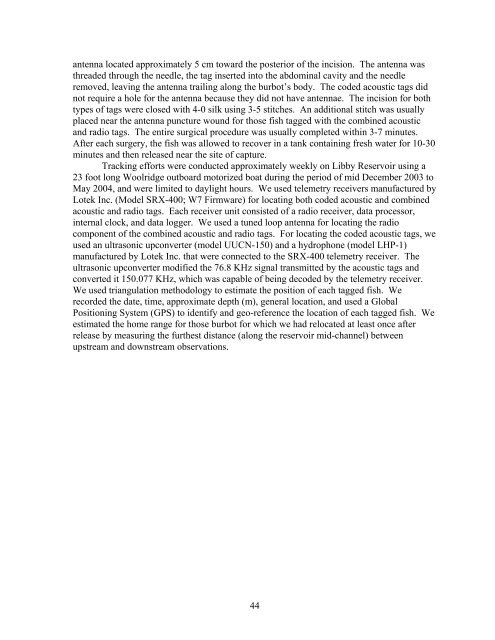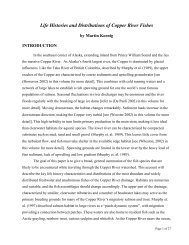Mitigation for the Construction and Operation of Libby Dam
Mitigation for the Construction and Operation of Libby Dam
Mitigation for the Construction and Operation of Libby Dam
Create successful ePaper yourself
Turn your PDF publications into a flip-book with our unique Google optimized e-Paper software.
antenna located approximately 5 cm toward <strong>the</strong> posterior <strong>of</strong> <strong>the</strong> incision. The antenna was<br />
threaded through <strong>the</strong> needle, <strong>the</strong> tag inserted into <strong>the</strong> abdominal cavity <strong>and</strong> <strong>the</strong> needle<br />
removed, leaving <strong>the</strong> antenna trailing along <strong>the</strong> burbot’s body. The coded acoustic tags did<br />
not require a hole <strong>for</strong> <strong>the</strong> antenna because <strong>the</strong>y did not have antennae. The incision <strong>for</strong> both<br />
types <strong>of</strong> tags were closed with 4-0 silk using 3-5 stitches. An additional stitch was usually<br />
placed near <strong>the</strong> antenna puncture wound <strong>for</strong> those fish tagged with <strong>the</strong> combined acoustic<br />
<strong>and</strong> radio tags. The entire surgical procedure was usually completed within 3-7 minutes.<br />
After each surgery, <strong>the</strong> fish was allowed to recover in a tank containing fresh water <strong>for</strong> 10-30<br />
minutes <strong>and</strong> <strong>the</strong>n released near <strong>the</strong> site <strong>of</strong> capture.<br />
Tracking ef<strong>for</strong>ts were conducted approximately weekly on <strong>Libby</strong> Reservoir using a<br />
23 foot long Woolridge outboard motorized boat during <strong>the</strong> period <strong>of</strong> mid December 2003 to<br />
May 2004, <strong>and</strong> were limited to daylight hours. We used telemetry receivers manufactured by<br />
Lotek Inc. (Model SRX-400; W7 Firmware) <strong>for</strong> locating both coded acoustic <strong>and</strong> combined<br />
acoustic <strong>and</strong> radio tags. Each receiver unit consisted <strong>of</strong> a radio receiver, data processor,<br />
internal clock, <strong>and</strong> data logger. We used a tuned loop antenna <strong>for</strong> locating <strong>the</strong> radio<br />
component <strong>of</strong> <strong>the</strong> combined acoustic <strong>and</strong> radio tags. For locating <strong>the</strong> coded acoustic tags, we<br />
used an ultrasonic upconverter (model UUCN-150) <strong>and</strong> a hydrophone (model LHP-1)<br />
manufactured by Lotek Inc. that were connected to <strong>the</strong> SRX-400 telemetry receiver. The<br />
ultrasonic upconverter modified <strong>the</strong> 76.8 KHz signal transmitted by <strong>the</strong> acoustic tags <strong>and</strong><br />
converted it 150.077 KHz, which was capable <strong>of</strong> being decoded by <strong>the</strong> telemetry receiver.<br />
We used triangulation methodology to estimate <strong>the</strong> position <strong>of</strong> each tagged fish. We<br />
recorded <strong>the</strong> date, time, approximate depth (m), general location, <strong>and</strong> used a Global<br />
Positioning System (GPS) to identify <strong>and</strong> geo-reference <strong>the</strong> location <strong>of</strong> each tagged fish. We<br />
estimated <strong>the</strong> home range <strong>for</strong> those burbot <strong>for</strong> which we had relocated at least once after<br />
release by measuring <strong>the</strong> fur<strong>the</strong>st distance (along <strong>the</strong> reservoir mid-channel) between<br />
upstream <strong>and</strong> downstream observations.<br />
44
















